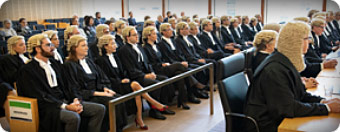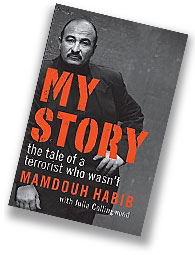The Tale of a Terrorist Who Wasn’t
By Mamdouh Habib with Julia Collingwood
Published by Scribe Publications
Reviewed by Elizabeth Gass
Terrorism has had many impacts on our world, not the least being a major curtailment of human rights.
The consequences of counter terrorism policies have been described recently in an International Commission of Jurists Report by the Eminent Jurists Panel on Terrorism, Counter-Terrorism and Human Rights, who stated: –
“…in the formulation and implementation of counter-terrorist policies, established principles of international human rights and humanitarian law are being questioned and at times ignored, not only by regimes whose record for doing so is well known, but also by liberal democracies that used to be in the forefront of promoting and protecting human rights.”1
It is in this context that this book is a sobering read. Mamdouh Habib, in conjunction with Julia Collingwood, has written the book to fulfill a promise he made to his fellow detainees at Guantanamo Bay that he would “tell the world what crimes were being committed at Guantanomo in the name of democracy and the fight against terrorism.” The book is also the story of Mamdouh’s life.2
Particularly in the first four chapters, this is not a particularly well-written book, containing a huge amount of detail delivered in the first person in many short sentences. It feels at times as if the book is simply a publicity vehicle for Mamdouh to put his own spin on much of what happened to him, and his beliefs and thoughts about people and groups he came in contact with. It is a challenge to read much of the book with an open mind as the authors recount the many coincidences that occurred in Mamdouh’s life which resulted in his being in the wrong place at the wrong time.
For example, when Mamdouh and his family were visiting New York, they happened to attend the trial of El Sayyid Nosair who had been accused of murdering Rabbi Meir Kahane at the Marriott Hotel in New York in 1990. Mamdouh recounts meeting, among others, two Egyptians, Ibrahim El-Gabrowney, and Mahmoud Abouhalima, who were both later found guilty of involvement in the 1993 bombing of the World Trade Centre. Further examples include staying at a Lashkar-e-Toiba run guesthouse in Pakistan, a group that in 2003 was, in Mamdouh’s words, “outlawed by the West as a dangerous terrorist organization,” and meeting David Hicks in Pakistan in early 2000, and David Hicks and Jack Thomas in Kabul in 2001.
But, overall, the book is important in reminding us how the “war on terror” has swept aside basic human rights and how even countries such as Australia are unable to, or choose not to, protect their citizens abroad.
Mamdouh recounts a shocking story that started when he was seized at a roadblock with three others just outside Lahore in Pakistan. After being blindfolded, the group was taken to a small building where it appears that two of the party were shot. Mamdouh and the remaining man were subsequently dumped in the countryside and, after much journeying, arrived in Kabul where Mamdouh stayed at a number of guesthouses, including one where both David Hicks and Jack Tomas were staying. It was at this guesthouse that Mamdouh heard that America had been attacked – this was the attack of 9/11.
In early October, Mamdouh traveled to Quetta in Pakistan, intending to travel back to Australia via Dubai and Singapore. According to Mamdouh, he befriended two young German men who were also trying to leave Pakistan and, together, they took a bus to Karachi, from where Mamdouh was to leave for the flight home. During the bus ride, at around 3am, the bus stopped and was boarded by three Pakistani men. According to Mamdouh, these men started yelling at the German men and Mamdouh intervened to help them. The result was that Mamdouh and the two German men were taken off the bus, manacled and hoods were placed over their heads. They were driven to a building and placed in cells where they remained for about 3 days, before being manacled and hooded again, driven eight or nine hours and then placed again in cells which were in a large compound with a barbed wire fence at the perimeter.
The conditions in this facility were primitive and frightening. Mamdouh was held here for about two weeks before he was informed that he would be taken to Islamabad airport from where he could fly home. After a check up at a local hospital, Mamdouh and the two German men were driven to Islamabad airport. Instead, however, of being put on a plane, they were put into a four wheel drive vehicle and driven to a building which again contained cells. They stayed there for about 11 days.
Mamdouh recounts that, twice during this time, he was taken to what he believes was the Australian High Commission in Islamabad and to a consular official named Alastair Adams. Judge Madwick found, in later court proceedings, that no meeting occurred in the Australia High Commission in Islamabad.3 Government evidence in that hearing was that Mr Paul Stokes of ASIO and Mr Briskey of the Australian Federal Police attached to the High Commission did meet with Mamdouh Habib on several occasions at “safe houses” apparently controlled by Pakistanis.4
Mr Habib claims in his book that he informed the Australian officials that he was being badly treated by the Pakistanis and that the officials told him that they could not help; that he was no longer an Australian citizen; and that he was to be sent to Egypt.
Mr. Habib describes being tortured after his second meeting with the Australian officials and, some time later, being beaten up by Americans while armed Pakistanis watched. Some time after this, he was transported in inhumane circumstances to Egypt.
Once incarcerated in Egypt, Mr Habib details being subjected to extensive and repeated torture. According to Mr Habib, he was being asked to confess to being a terrorist throughout these ordeals. The details of the torture used on Mr Habib and other inmates are sickening. Mr Habib describes questions that could only have been framed on the basis of extensive knowledge of his life in Australia, and he believes that ASIO provided this information.5
Eventually, Mr Habib was flown to Pakistan, taken by road via Bagram and then flown to Kandahar to an American run facility where people were kept in cages containing 20 to 60 people. Mr Habib was in very poor physical and mental condition by this time and, after barely two weeks, he was flown to Guantanamo Bay, where he was placed in the hospital. He recollects being placed on a gurney and being wheeled to meet with some Australians, who he now knows to have been an ASIO agent and Australian Federal Police officers, and a female representative from Department of Foreign Affairs and Trade. These visitors told Mr Habib that he had been captured in a war situation and that is why he was there. Mr Habib recalls that none of the visitors was interested in the fact that he had been given drugs and beaten.
Mr Habib was then taken to a dark metal cell in the isolation area of Block India. What followed was a dehumanizing experience which consisted of poor conditions, repeated interrogations, heavy drugging, sleep deprivation, extreme physical conditions such as being left naked in freezing cold rooms for hours, and being threatened with rape. Mr Habib describes the torture as “psychological manipulation and humiliation and slowly driving you mad.”6
Mr Habib describes in detail the levels that were allocated to detainees depending upon their level of cooperation; recounts stories of the many other inmates that he came into contact with; and tells of the strategies employed by the inmates, individually, or as a group, to unsettle and make things more difficult for the Americans. By 2004, Mr Habib experienced heavy pressure, with interrogations day and night; being constantly moved; and extensive sleep deprivation.
Sometime in the middle of 2004, Mr Habib was moved to Camp 5 and incarcerated in a cell of solid concrete. At this time, he was given a list of all the charges against him. Shortly after, Australia’s Consul General, Derek Tucker, came to see Mr Habib, a few times, asking him to co-operate. Mr Habib refused to cooperate because he did not trust Mr. Tucker. Mr Habib recounts that, at these meetings, he was brought into the room, shackled and then handcuffed to the floor, to conduct his conversations with Mr Tucker. Mr Habib claims that Mr Tucker told him that, if Mr Habib did not co-operate, he would be sent to Camp 6 which would be even worse than Camp 5, or he would be sent back to the Egyptians.
If true, these claims suggest that the Australian government and its consular officials, in particular, did not see its role as standing up for the rights of one of its citizens. This is contrary to what we are told by Department of Foreign Affairs and Trade officials every time an Australian overseas is in trouble. It is also contrary to what the citizens of every civilized country should be able to expect what their government and consular officials.
The book ends with Mr Habib describing his difficulties after he did eventually return to Australia. Whether or not Mr Habib had a plausible explanation for being in Afghanistan, or for providing contradictory evidence in various court hearings, the reader is left with the inescapable conclusion that he was held in custody in appalling circumstances; his human rights were abused; and the Australian government did little, if anything, to protect his rights.
Elizabeth Gass
Footnotes
- The International Commission of Jurists Eminent Jurists Report can be found at http://icj.org/news.php3?id_article=4453&lang=en
- Preface, p vi.
- Habib v Commonwealth of Australia [2008] FCA 489.
- The government’s evidence was that Mr Stokes (a nom de guerre being an assumed identity under the Crimes Act 1914 (Cth)) attended an interview with Mamdouh Habib on 24 October 2001, and Mr Briskey on 26 and 29 October 2001. Mr Stokes interviewed Mr Habib on three occasions at safe houses and on the last two occasions Mr Briskey was present. Mr Alastar Adams gave evidence that he was a long-serving officer of the Australian Department of Foreign affairs and Trade, and was the Consul at the High Commission in Islamabad in October 2001. He did not meet with Mr Habib in October and had no knowledge of Mr Habib being at the High Commission, but did confirm Mr Briskey’s account of the meetings.
- Interestingly, the Binyam Mohamed litigation in the United Kingdom revealed a similar pattern where Binyam’s interrogations in Pakistan and Jordan involved knowledge that could only have come from United Kingdom officials. See [2008] EWHC 208 (21 August 2008) [2008] EWHC B23 (29 July 2008); [2008] EWHC 2519(22 October 2008); [2008] EWHC 208 (21 August 2008); [2009] EWHC 152 (04 February 2009); [2009] EWHC 571 (23 March 2009).
- Page 156.



